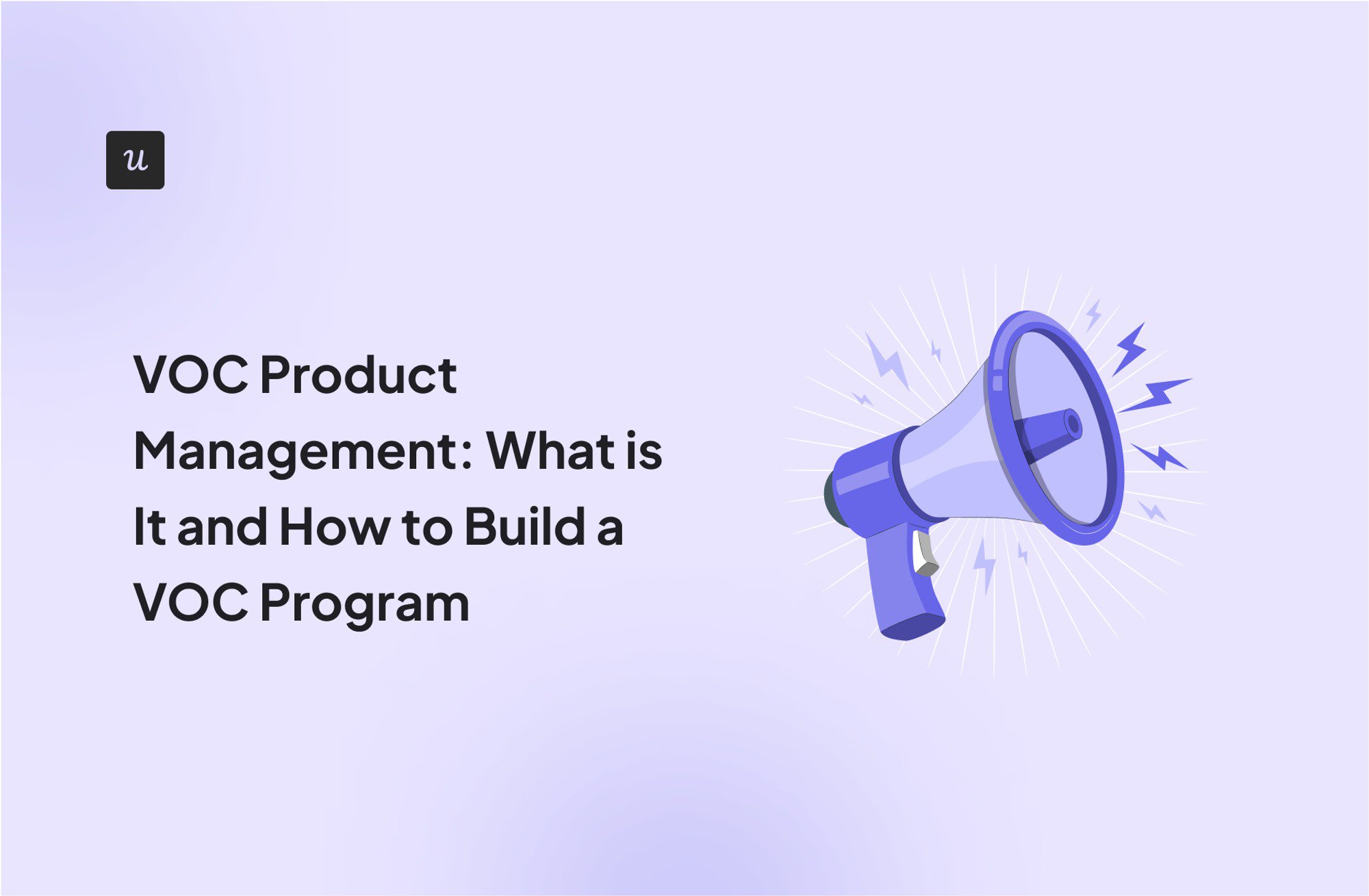
VOC in Product Management: What is it and How to Build a VOC Program
Collecting the voice of the customer (VoC) in product management can lead to sustained growth.
You can have the best digital marketing and pricing strategies, but you won’t be able to retain your customers if you don’t listen to their feedback.
In this article, we’ll show you how to collect user feedback and which metrics to track. We’ll also explain how to build a VoC program with insights that continuously influence product decisions.
Try Userpilot Now
See Why 1,000+ Teams Choose Userpilot

Overview of VOC in product management
- The VoC is the process of continuously gathering and analyzing customer feedback from multiple sources and summarizing it in one place.
- It’s important to track the VoC in product management. Doing so drives customer-centric product development, increases data-informed decisions, and enables continuous improvement.
- To collect VoC insights, you can:
- Use in-app surveys.
- Plan user interviews and focus groups.
- Measure satisfaction with your customer support services.
- Monitor online reviews.
- To build a VoC program, you need to:
- Set goals. Determine what you’ll do with customer feedback.
- Implement data collection strategies. Define how you’ll gather the feedback.
- Analyze survey data to spot pain points. Set up a process to review the collected data and plan the next steps.
- Close the feedback loop. Determine when and how you’ll get back to the user to inform them about changes.
- You should track customer metrics over time to determine your VoC program’s success, some include:
- Net Promoter Score.
- Customer satisfaction score.
- Customer effort score.
- Feature usage.
- Retention rate.
- Get a demo today to see how you can collect user feedback, analyze the data, and take in-app action to drive product-led growth with Userpilot!
What is the voice of the customer (VoC)?
The voice of the customer (VoC) is the process of collecting user feedback from multiple sources and organizing it in one place for easy review.
This document helps companies map out what’s working and what’s not, identify user pain points, and come up with an action plan.
How important is VoC in product management?
The VoC is critical in product management as it helps the product team think with the end user in mind and guide product innovations.
You can’t skip VoC in product management as it:
- Enables customer-centric product development. Ideate and prioritize product enhancements based on customer preferences, comments, and feedback. This allows product owners to find solutions in the field and not in the boardroom.
- Increases data-informed product decisions. The VoC gives you tangible information that simplifies the decision-making. For example, choosing to prioritize one feature over another based on VoC data can improve the user experience.
- Allows for continuous improvement. The VoC simplifies continuous product optimization as you get to improve different aspects of your tool based on user feedback.
How to collect the voice of the customer insights
There are multiple ways of gathering your customers’ thoughts. Here are five methods to include in your VoC strategy:
1. Collect customer feedback data using in-app surveys
Trigger surveys based on your users’ interactions to get contextual feedback. For example, add a rating scale survey to the bottom of the screen to get in-app feedback about a specific feature. This allows you to collect customer sentiments with higher credibility by asking them on the spot.
You can also use NPS surveys to gather high-level feedback about your product. Try to include open-text follow-up questions to gain valuable insights from the user.
Here are examples of voice of the customer questions to ask:
- On a scale of 1-10, how satisfied are you with our product/service?
- Agree or disagree: [feature X] is easy to use.
- Have you encountered any issues or difficulties while using our product/service? If yes, please describe.

2. Organize interviews and focus groups to gauge customer expectations
Gain deeper insights or clarify previous negative feedback by setting up one-on-one interviews or focus groups with customers.
Ask open-ended questions starting with who, what, why, when, and where to get the customer to speak. For example, “What’s your favorite thing about the product?”
Another good idea is to ask customer-specific scenario-based questions during the session. For example, “Imagine you want to do X on our platform, which actions would you take to complete that task?”
Avoid asking leading questions or use only close-ended questions. These tend to direct the answer to what you want to hear and derail the purpose of the meeting.
3. Conduct usability tests to understand user behavior
Usability tests are one of the most powerful ways of gaining customer feedback and putting yourself in the users’ shoes. Being able to evaluate how customers interact with your product gives you a lot of insight into the customer experience.
You can conduct usability tests via a path analysis to evaluate the product experience. Do users follow your expected flow? Did they find a better alternative? Can you make the instructions clearer?

But you can also try other usability testing methods, like 5-second testing or unmoderated testing. Either way, make sure you take note of the findings and add them to the voice of the customer file.
4. Measure customer satisfaction with/through support services
Your customer support team is a gold mine for gathering feedback. On one side, the customer service team will know which are the most repeated issues or which features are harder to understand. But also, this team is the face of your company. The way they behave impacts your brand perception.
Make sure you review historical support tickets and customer complaints and add them to the voice of the customer file.
Then, stay on top of how your support team is perceived by users and act to close the customer service gap, if any. The best way to do this is to trigger a quick customer service survey after any interaction with the support team to measure the customer experience.

5. Monitor review sites to collect customer loyalty insights
Go to websites like G2, Capterra, Clutch, or SoftwareAdvice and read user reviews. There, you can see what your customers like and dislike about your product, why they chose you over competitors, or what they’d like you to improve.
It’s good practice to look at these sites periodically as a free way to gain customer feedback. Make sure to answer users’ reviews in a positive tone to show that you’re willing to improve based on their comments. This can help build customer loyalty and increase customer satisfaction.

How to build a Voice of the Customer program
Now that you know how to find customer feedback, you can build a program to organize, review, and standardize their voice collection in a standard process. Here’s how to do it:
1. Set goals for your voice of the customer program
Why do you want to collect customer feedback? What are your objectives behind this?
Maybe you want to improve product satisfaction, increase retention levels, or drive product-led growth. In any case, determine your main objectives before you begin as they will guide the rest. Choose the goal-setting framework of your preference.
Once you’ve determined your objectives, go ahead and define the type of data you’ll collect, the metrics you’ll monitor, and how often you’ll update the document. Also, remember to define how you’ll distribute the voice of the customer information to the whole company.

2. Implement data collection strategies
List all the different methods you’ll use to collect data from your customers. Refer back to the previous section to choose the ones that align with your goals. You can mix VoC surveys, interviews, user behavioral data, or reading online reviews.
For example, to improve product satisfaction you can host focus groups, conduct usability tests, or do event tracking in Userpilot.

3. Analyze data to understand pain points and customer needs
Go through all of your data as part of your voice of customer analytics and spot the recurring themes.
- To analyze qualitative data: Assign tags to each text response or verbatim to identify pain points and track those issues over time.
- For quantitative data: Turn your results into graphics so you can review your metrics on a single view. For example, analyze NPS responses by building an NPS dashboard for insights at a glance.
Compare the results to previous periods.

4. Close the feedback loop
Lastly, is a VoC best practice to follow up and get back to users so they know that their opinions are heard, especially to detractors. You want to make sure they can go from having a not-so-satisfying experience to one they’d recommend to others.
For example, if you receive multiple complaints about a particular feature being overly complicated, add in-app messages to announce that you’re working on it. You could also set triggering conditions to deliver support until you find a more permanent fix.

Another idea to close the customer feedback loop is to offer contextual help and in-app walkthroughs in case you can’t solve the issue right away.

In any case, always mention that you listened to their feedback and are acting upon it. This encourages them to continue speaking their minds in the future.
Important metrics to track the voice of the customer
Your VoC file should have a main view with key metrics, a list of pain points, a section for action steps, and an addendum with users’ verbatim.
Here are the metrics to include in the main view:
- Net Promoter Score (NPS). Measure customer loyalty by asking users how likely they are to recommend your product or service on a scale of 0 to 10.
- Customer Satisfaction (CSAT). Determine how satisfied customers are with your product, service, or particular interactions.
- Customer Effort Score (CES). Measure how easy it is for customers to complete tasks or resolve issues when using your product or service. Check out this customer effort score survey template.
- Feature usage rate. Track the engagement of a particular feature of your product or service to understand which functionalities are most valuable and which may need improvement.
- Retention rate. The percentage of customers who continue to use a product or service over a defined period.
Conclusion
Implementing a VoC program in your company can help product managers stay on top of customer feedback. This continuous study of your users’ perceptions can help you come up with new feature ideas or product improvements.
You can collect the VoC through in-app surveys, by conducting meetings, or by reading online reviews. In any case, you need to have a clear goal and a plan to turn feedback into action.
To gather user feedback, analyze your customers’ behavior, and add in-app guidance for product-led growth, try Usepilot. Get a demo.








